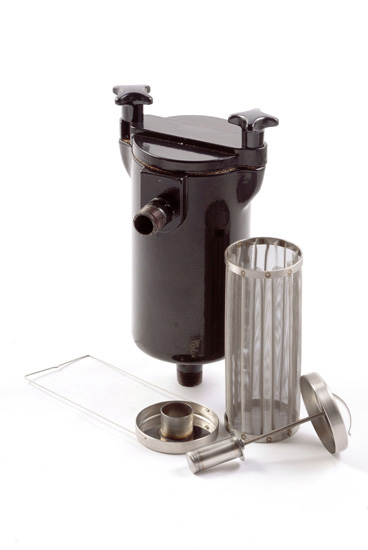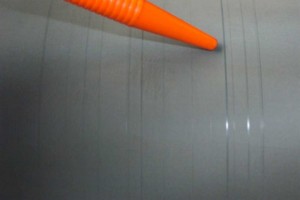Ask the person in charge of ordering anilox rolls what their greatest fear is and the answer you're likely to get is "that the rolls will get scored as soon as we put it in the press." It's still not that uncommon to hear.
Excluding accidental occurrences such as a blade hold-down screw or other machine parts coming into contact with the surface of a rotating anilox roll, a score on an anilox roll is the result of a tiny, hard particle becoming wedged under the leading edge of a doctor blade while the anilox roll rotates. This action creates the characteristic line around the roll's surface that we commonly call a "score line."
Besides the obvious damage to the roll itself, a scored anilox can result in a visible line in an image, usually darker than the rest of the image, in the web direction. The defect is often unacceptable and can result in downtime to swap the roll, reposition the print, or execute some other fix. A common misconception is that light (weak) printed visible lines in the web direction are score lines as well. When solid ink particles or debris becomes lodged between the doctor blade and the anilox the cell can clog resulting in the affected cells lacking volume. This print defect can often be corrected by properly cleaning the anilox in the affected area. Regardless of whether the anilox is scored or cell are clogged, the result is delays at downstream operations, material losses, or even a loss of a customer.
The offending particle will likely be delivered to the blade tip via the ink. Filtering the ink in-line may capture that particle before it reaches the blade. Yet, it is still not unusual to see flexo converters not filtering their inks in-line during press operation.
Why do many in our industry still resist in-line ink filtration? Some may still not realize that in-line ink filtration is one of the most effective ways to remove hard particles suspended in their ink and reduce the incidence of anilox scoring. The hard particles that score the surfaces of anilox rolls can be sand, grit, or dust brought in under shoes. They can be blown in through dock doors, transferred from cleaning tanks or recycled rags, or distributed on forklift wheels. They can be ferrous or non-ferrous metallic bits, from doctor blade or other equipment wear. They can stow away in solvent containers and be poured into ink or travel through galvanized pipes from supply tanks directly into ink sumps. They can be incompletely milled pigments or tiny ceramic chips from anilox roll ends or come from any of a number of other possible sources. In the end, though, it's hard particles wedged under doctor blades that do the evil deeds. These offensive little particles are persistent, too. No matter how careful we are about keeping them out of our ink, some of them will find their way into it. Therefore, aside from taking precautions avoid contamination; the most effective thing we can do to prevent scoring is to filter the ink in-line.

In -line filters are wire screen meshes inserted into some form of housing with an inlet and outlet for the ink to pass through on its way to the ink pan or doctor blade chamber. Powerful rare-earth magnets should be incorporated into the housing so that some of the ferrous metallic bits that may be suspended in the ink can be grabbed by the magnet. However, not all particles are metal, and of those that are not all are ferrous or contain iron. Only ferrous particles are attracted to magnets, and of those that might get into your ink, not all will pass close enough to the magnet to be grabbed. Therefore, the screen filter is most important element of the filter system.
Important factors concerning the filter and defining the mesh size are the wire composition, wire thickness, the number of wires per linear measure or holes per square unit of measure, the hole size, and the surface area of the screen.
The mesh must survive the conditions it will be exposed to, so it is usually made of stainless-steel wire. The mesh should be fine enough to catch particles that are likely to cause damage, but open enough to allow ink to flow through it freely during normal operation without becoming clogged too quickly and starving the print station of ink. It is a delicate balance and it may take experimentation with various mesh sizes to arrive at the right size. Once the optimal mesh size is established, the mesh surface area will dictate how long the ink will flow freely before the filter becomes too clogged and needs to be swapped or cleaned. Therefore, the filters used in one of the more common filter systems are a corrugated tube instead of a simple smooth tube, translating to greater surface area.
I have been asked whether a filter should be installed after the pump and before the ink reaches the print station, or after the station and before it reaches the ink sump. Yes, filters installed between the pump and print station catch particles before they reach the station. However, and perhaps more importantly, if a filter were placed after the print station and before ink sump, there would be a risk of ink overflow or excess pressure at the print station as the filter becomes clogged. This is one reason you will see pre-assembled, off-the-shelf systems set up so that ink is filtered after the pump and before the print station.
Because an in-line filter is placed between the pump and print station as it captures particles and other debris, the flow to the station may be reduced resulting in ink starvation and necessitating an increase in ink flow or pressure to the station. A filter of appropriate mesh size and surface area will allow the filter to capture contamination for a reasonable amount of time (at least one shift) before becoming so clogged that, even at full flow, the ink volume to the station is not adequate and it's time to replace the filter. To ensure the minimum disruption and mess, replacing filters is recommended if possible, to be done off-line with the operator simply swapping a complete pump and filter assembly and reattaching hoses. It may require an additional pump, but the impact on productivity and the reduction in the resistance to filter use will be worth it. Besides having to shut down to swap filters if done at press, there is a possibility of reintroducing captured particles during the swap or of making a mess resulting in even more downtime. If you must swap filters at press, having spare filters on hand will help reduce downtime. In either case, use quick-disconnects where possible and appropriate.
Many, especially in narrow web, who primarily pour ink into pans or use small peristaltic pumps, it can be a challenge to incorporate in-line filters. In these cases, the only option may be to strain the inks as they go to press and/or return from it, using cheesecloth, household paint strainers, or similar mesh products. However, if the situation lends itself to in-line ink filtration, I encourage everyone to consider implementing in-line ink filtration.
A final thought... I recall a conversation with a press helper regarding an anilox roll scoring issue. When I asked him why there were in-line ink filters on the staging rack but none being used on press, he replied, “Well, the filters seem to work well and it did reduce scoring, but we had to keep stopping and cleaning the filters because they would clog up.” I was speechless. Working with in-line filters and magnets will require additional efforts to your process controls but in the long run will be well worth it (even if they get clogged up occasionally).


